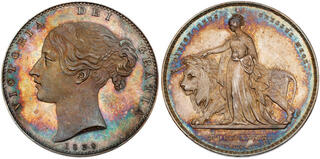| Ira & Larry Goldberg Coins & Collectibles > Auction 137 | Auction date: 29 January 2024 |
| Lot number: 1164 Price realized: 340,000 USD (Approx. 314,908 EUR) Note: Prices do not include buyer's fees. | Show similar lots on CoinArchives Find similar lots in upcoming auctions on |
| Lot description: Great Britain. Silver Pattern Crown, 1839. Linecar & Stone-36; ESC-2649 (332) Rarity 7. In silver on a thin flan weighing 21.19g. By W. Wyon. Victoria, 1837-1901. Young head left, W WYON.RA on truncation, date below. Reverse; DIRIGE DEUS GRESSUS MEOS., Una and the Lion, date in roman numerals and W.WYON R.A. in exergue, edge inscription DECUS ET TUTAMEN ANNO REGNI TERTIO. Beautiful irisdescent tone. Excessively rare, this believed to be only the second recorded specimen. The other known example is the Whetmore/Murdoch/Montagu/Pendlebury specimen. PCGS graded Proof 63. Estimated Value $50,000 - UP Portrait of the young Victoria without crown, her hair bound by two "fillets" and tied in a pony-tail, with her name and "By the grace of God" in Latin surrounding. The beautiful reverse design was inspired by a classic poem that remained popular for two and a half centuries in Great Britain-Edmund Spenser's The Faerie Queene. A long tale of great complication, it was about a mythic being simply named Una, which meant "One" and stood for the first and greatest godly value-truth. Early in the story of the Faerie Queen, while metaphorically wandering around the kingdom of King Arthur, Una encounters a lion. Instead of fiercely attacking her, the lion caresses her and immediately becomes her companion, guarding her and leading the way on her journey. She ends up in Eden. The Royal Mint's William Wyon translated this story into the dramatic image seen on this coin's reverse. The large central motif is surrounded by a legend in Latin translating to mean "May God Guide My Steps" (some would say "footsteps") with the date 1839 beneath in roman numerals and the "signature" of the Royal Mint's engraver William Wyon, RA (standing for Royal Academy). While it is hard to believe today, in 1839 this design was controversial at the mint, whose officers felt that, despite its obvious beauty, the image was of such high relief that it would not strike up consistently as a coin for commerce. This was the essential reason for the existence of patterns or "off strikes" in other metals-to test the dies. The decision was reached to strike the coin only in proof state and in gold for Victoria's Coronation Proof Set of 1839. For the set, some 300 coins were minted initially, although restrikes continued for years in response to collector demand. By contrast, this pattern is of extreme rarity: just 3-5 are known in silver. Ex Baldwin's Auction 42, Sept 26, 2005, lot 1163. |  |


